Over the Isles to America
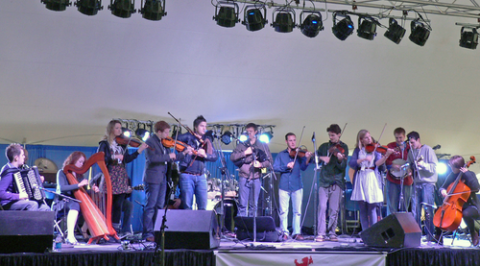
The 21 members of the Transatlantic Seaway Music Collaboration fill the stage at the New Hampshire Highland Games.
Photo by Danielle Dreilinger
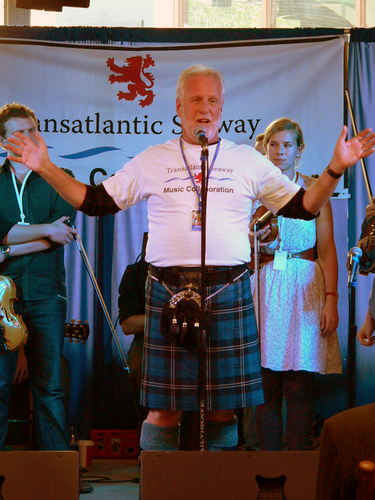
Larry Bethune, Berklee vice president for student affairs/dean of students and a longstanding presence in the Scottish music community, introduces the group.
Photo by Danielle Dreilinger
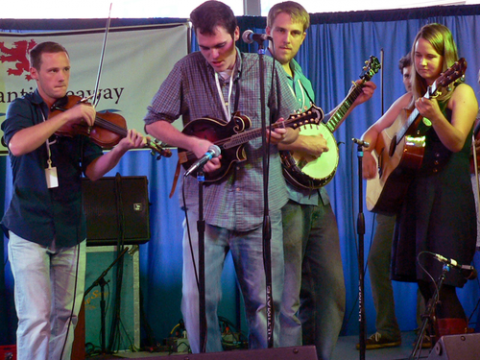
Berklee shows off its strength in Scottish music gone Appalachian. From left: Trent Freeman, Eric Robertson, Lukas Pool, Courtney Hartman
Photo by Danielle Dreilinger
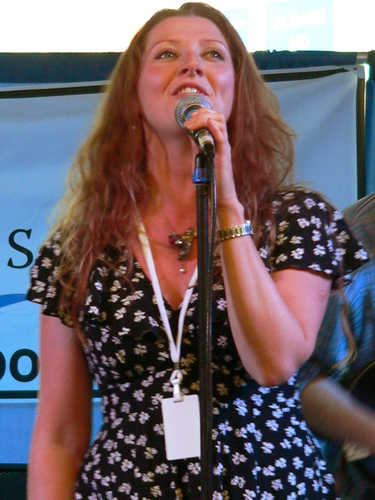
Singer Maureen McMullan '10 already was a transatlantic musical partnership—she studied at both Berklee and the University of Strathclyde.
Photo by Danielle Dreilinger
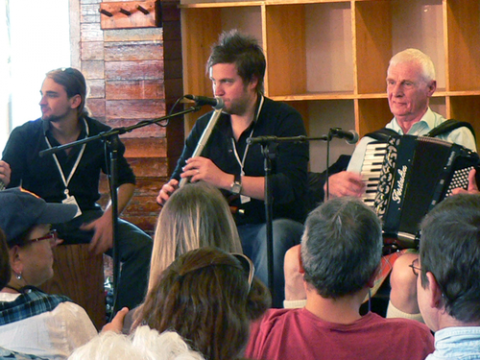
Berklee alumnus Giancarlo de Trizio and Glasgow-based piper Finlay MacDonald join accordionist John Carmichael as his impromptu backing band.
Photo by Danielle Dreilinger
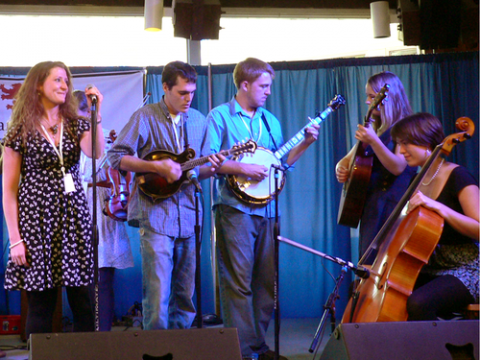
Berklee musicians perform a song popularized by bluegrasser Alison Krauss. From left: Maureen McMullan '10, Eric Robertson, Lukas Pool, Courtney Hartman, and Monica de Vitry
Photo by Danielle Dreilinger

Ainsley Hamill of the Royal Academy shifts from traditional "mouth music" to a jazzy ballad.
Photo by Danielle Dreilinger
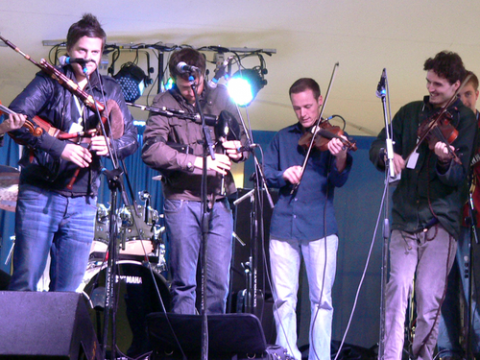
The collaboration in action: (left to right) pipers Finlay MacDonald and James MacKenzie from the Royal Scottish Academy of Music and Drama with fiddlers Trent Freeman and Duncan Wickel of Berklee.
Photo by Danielle Dreilinger
At first glance, a visitor to the Woodstock Inn on September 17 might think they'd walked into an ordinary Celtic music session, with musicians wailing away on traditional Scottish reels. But look again, and they'd see the multitude of men in kilts. And the guy adding percussion not on an Irish bodhran but on a cajon box. Listen, and anyone quickly realized the music itself was well above standard pub quality—as the packed room whooped and cheered.
It was the first night of the annual New Hampshire Highland Games, site of the knockout debut of the Transatlantic Seaway Music Collaboration (TAS), a new project of Berklee, the Royal Scottish Academy of Music and Drama, and University of Strathclyde showcasing the sources and pathways of Scottish music.
David Christie, longtime announcer for the New Hampshire games, watched from a few feet away. "From a very simple idea in the first place, this thing could have tremendous legs," he said.
From Both Countries, a Vision
A simple idea, indeed. It started with Berklee vice president for student affairs/dean of students Larry Bethune, who had a longstanding love for Scottish tradition and a friendship with Mark Sheridan, head of the Strathclyde music program.
Meeting at festivals like Celtic Connections in Glasgow, "there was always pub talk about how we should do something," Bethune said. "I've been wanting to build a bridge." He and Sheridan envisioned a musical partnership that spanned the seaway like the boats that brought immigrants—including Bethune's ancestors—from Scotland to the United States.
At the same time, the college was working towards its new American Roots Music Program, a focused area of study that encompasses not only United States folk genres but Celtic influences before them. Bethune dreamed of making Berklee—which already boasted renowned alumni such as fiddler Hanneke Cassel and vocalist Maureen McMullan, both of whom performed at the New Hampshire games—a worldwide educational destination for contemporary Celtic musicians.
On the other side of the pond, the Academy is Scotland's national conservatory, with the only bachelor's degree in traditional Scottish music in the world and a relationship with the National Piping Centre. Strathclyde, a smaller program, combines traditional music with a commercially oriented pop and jazz focus. The TAS also had support from Glasgow UNESCO City of Music, where both colleges are based.
The opportunity finally began to unfold when John Wallace, principal of the Academy (and the trumpet soloist at Charles and Diana's wedding), was appointed honorary chieftain of the New Hampshire games in 2008. Before the event, he toured Berklee and met president Roger H. Brown.
Unbeknownst to Bethune, Wallace and Christie had been discussing a similar idea. About a month later, Christie asked Wallace what he still wanted to achieve at the Academy. "The first words out of his mouth were 'a cultural and musical bridge over the Atlantic,'" Christie said. "I still have a piece of paper on which I drew a picture of a bridge during that conversation."
Once all the partners shared their vision, the project "took on a life of its own," Bethune said. (With a lot of behind-the-scenes work, of course.)
The Scots Cross the Seaway
It all started for real when the 21 performers met for the first time Wednesday, ready to arrange tunes. By Friday night they were jamming at the Woodstock Inn like old new pals. Simply put, the collaborators found they were in tune with each other.
"It's a trip," said Berklee old-time banjo player Lukas Pool.
"Really fun," said Berklee fiddler Trent Freeman. "We've been teaching each other tunes."
Even with little time to rehearse together, "They're so good, there's no difficulty working with them," said Jack Smedley, an Academy fiddle player. "There are more similarities than there are differences."
Freeman agreed. "When I grew up I played a lot of Celtic music," he said. "A lot of the tunes we play come from the British Isles."
"We found we were aiming for the same sound, the same level of energy and expression of emotion, and the same sense of time," said Glasgow multi-instrumentalist Hamish Napier. They even hooted and hollered at the same moments. "It was clear to me that we were essentially playing the same music."
(Napier was an academic partnership within himself: He attends Strathclyde, teaches at the Academy, and extended his trip to audition for Berklee.)
It might have helped that the Scottish points of the triangle were far from square. Smedley's heart lay in contemporary folk music. Finlay MacDonald is head of piping studies at the National Piping Centre in Glasgow, but his own band backs bagpipes with groove. Strathclyde guitarist Leo Forde is a jazzhead; after graduation "I'll be out of Scotland so the traddy thing will sort of go on the back burner."
One or two TAS members even held their own despite having no experience whatsoever with Scottish music—including percussionist Giancarlo de Trizio, a recent Berklee grad who rapidly became a coveted sideman. "It's somehow similar to where I come from" in Italy, he said. "There are lots of similarities between folk music all over the world."
Taking New Hampshire by Storm
The Scotland corner came out in force Saturday. But even surrounded by kilts, clans, caber tosses, and bagpipe armies, the TAS musicians stood out. They seemed to be everywhere at the New Hampshire Games, with so many appearances it didn't matter that the 9:00 a.m. concert main stage set started late due to the difficulty of sound-checking such a big group.
Accordionist John Carmichael was so impressed that he invited the Seaway to join him at lunchtime. It proceeded like musical chairs in reverse, with student after student coming up to perform: MacDonald, de Trizio, Napier. "They asked me to do one more and one more and one more," de Trizio said afterwards.
"It's a fantastic idea that Larry has of just very open collaboration," said Wallace, who pulled on a TAS T-shirt and stood outside the mainstage tent flagging down potential fans with Louise Mitchell of Glasgow UNESCO City of Music. "The fusion of the different approaches is very exciting. . . I think the two approaches are producing a very potent, heady result."
The pinnacle came Saturday afternoon at the Octagon Lodge, when the TAS played its full hour-long set that moved from group performance to individual school ensembles and back together at the end. The standing/stomping-room-only crowd clapped from the ninth bar of the fiddle intro.
The music, like the players, ranged all over the map. The Berklee group threw a few aggressive Appalachian licks into the traditional Scottish opener. Forde's electric guitar gave a funky flavor to a Strathclyde selection. Ainsley Hamill of the Academy lent a traditional song a contemporary delivery with her low, powerful voice. MacDonald switched from pipes to whistle to pipes again in the space of a single tune.
Even the small groups showed signs of quickly planned collaboration: de Trizio and Academy accordionist Grant McFarlane joined the Strathclyde musicians for a tune.
"It's like Scottish Parliament-Funkadelic," said fan Clifford Allen afterwards. "The best thing is just the melding of the American influence with the Scottish influence. They don't skimp on the entertainment, either."
The students were tired but thrilled. "I feel like it came miles from yesterday," Read said. De Trizio was considering learning Italian traditional music.
Napier called the experience "fantastic." He said, "The vibe on stage during performances was amazing. The late-night jam sessions we all had were just as exhilarating as the best performances—this is where we really let ourselves go."
A Return to the Old Country?
At the festival pub, Bethune and Sheridan toasted the students' success. "The governor of New Hampshire talked about us, the chieftain of the games talked about us," Bethune said, elated. "We've tapped into something we didn't expect."
"We knew it would work," Sheridan said. "The gift of music, the gift of collaboration, the gift of friendship." All they needed was more time: "These kids are bursting with ideas—there's so much more [we] could do."
All Napier wanted was "significantly more funding for the collaboration to flourish, through allowing us more time together to jam, rehearse, and perform. . . . The most expressive and interesting music will come from all three environments."
The audience response fed right into the organizers' not-so-secret goal: to expand the Transatlantic Seaway Music Collaboration to more colleges, more alumni—and across the Atlantic. Not long after, the group was invited to perform in Glasgow at January's Celtic Connections festival—taking the seaway, and the music, round about and back again.
